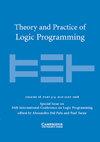Linear-Time Temporal Answer Set Programming
IF 1.1
2区 数学
Q3 COMPUTER SCIENCE, SOFTWARE ENGINEERING
引用次数: 11
Abstract
In this survey, we present an overview on (Modal) Temporal Logic Programming in view of its application to Knowledge Representation and Declarative Problem Solving. The syntax of this extension of logic programs is the result of combining usual rules with temporal modal operators, as in Linear-time Temporal Logic (LTL). In the paper, we focus on the main recent results of the non-monotonic formalism called Temporal Equilibrium Logic (TEL) that is defined for the full syntax of LTL but involves a model selection criterion based on Equilibrium Logic, a well known logical characterization of Answer Set Programming (ASP). As a result, we obtain a proper extension of the stable models semantics for the general case of temporal formulas in the syntax of LTL. We recall the basic definitions for TEL and its monotonic basis, the temporal logic of Here-and-There (THT), and study the differences between finite and infinite trace length. We also provide further useful results, such as the translation into other formalisms like Quantified Equilibrium Logic and Second-order LTL, and some techniques for computing temporal stable models based on automata constructions. In the remainder of the paper, we focus on practical aspects, defining a syntactic fragment called (modal) temporal logic programs closer to ASP, and explaining how this has been exploited in the construction of the solver telingo, a temporal extension of the well-known ASP solver clingo that uses its incremental solving capabilities.线性时间时态答案集规划
在这篇综述中,我们介绍了(模态)时间逻辑规划在知识表示和陈述性问题解决中的应用。这种逻辑程序扩展的语法是将常规规则与时间模态运算符相结合的结果,如线性时间时间逻辑(LTL)。在本文中,我们重点讨论了称为时间均衡逻辑(TEL)的非单调形式主义的主要最新结果,该形式主义是为LTL的完整语法定义的,但涉及基于均衡逻辑的模型选择标准,均衡逻辑是答案集规划(ASP)的一个众所周知的逻辑表征。结果,我们得到了LTL语法中一般情况下时间公式的稳定模型语义的适当推广。我们回顾了TEL及其单调基的基本定义,这里和那里(THT)的时间逻辑,并研究了有限和无限迹长之间的区别。我们还提供了进一步有用的结果,例如转换为其他形式,如量化平衡逻辑和二阶LTL,以及基于自动机结构计算时间稳定模型的一些技术。在本文的其余部分中,我们将重点关注实际方面,定义一个称为(模态)时态逻辑程序的语法片段,更接近ASP,并解释如何在求解器telingo的构建中利用它,telingo是众所周知的ASP求解器clingo的时间扩展,使用其增量求解功能。
本文章由计算机程序翻译,如有差异,请以英文原文为准。
求助全文
约1分钟内获得全文
求助全文
来源期刊

Theory and Practice of Logic Programming
工程技术-计算机:理论方法
CiteScore
4.50
自引率
21.40%
发文量
40
审稿时长
>12 weeks
期刊介绍:
Theory and Practice of Logic Programming emphasises both the theory and practice of logic programming. Logic programming applies to all areas of artificial intelligence and computer science and is fundamental to them. Among the topics covered are AI applications that use logic programming, logic programming methodologies, specification, analysis and verification of systems, inductive logic programming, multi-relational data mining, natural language processing, knowledge representation, non-monotonic reasoning, semantic web reasoning, databases, implementations and architectures and constraint logic programming.
 求助内容:
求助内容: 应助结果提醒方式:
应助结果提醒方式:


